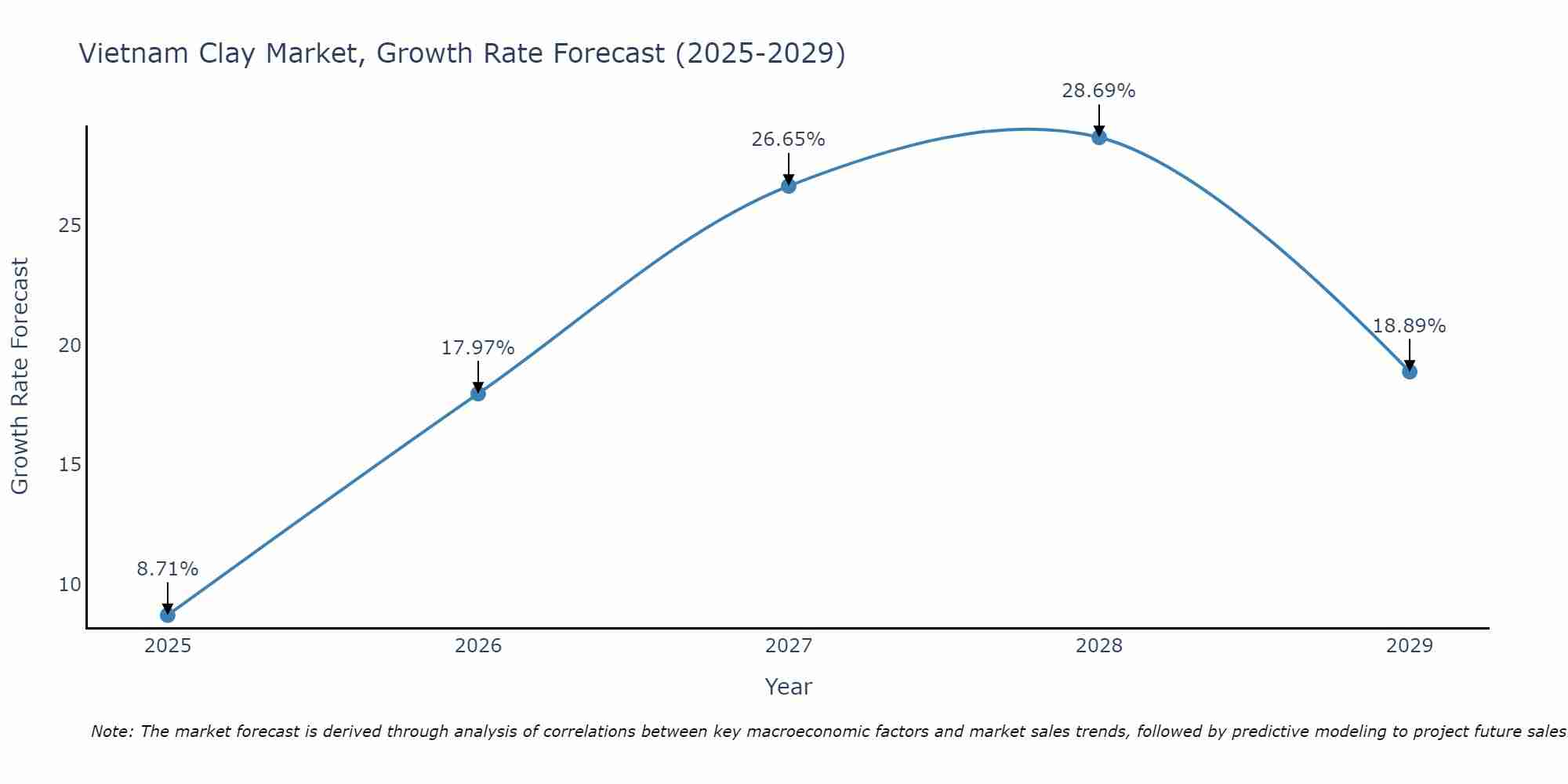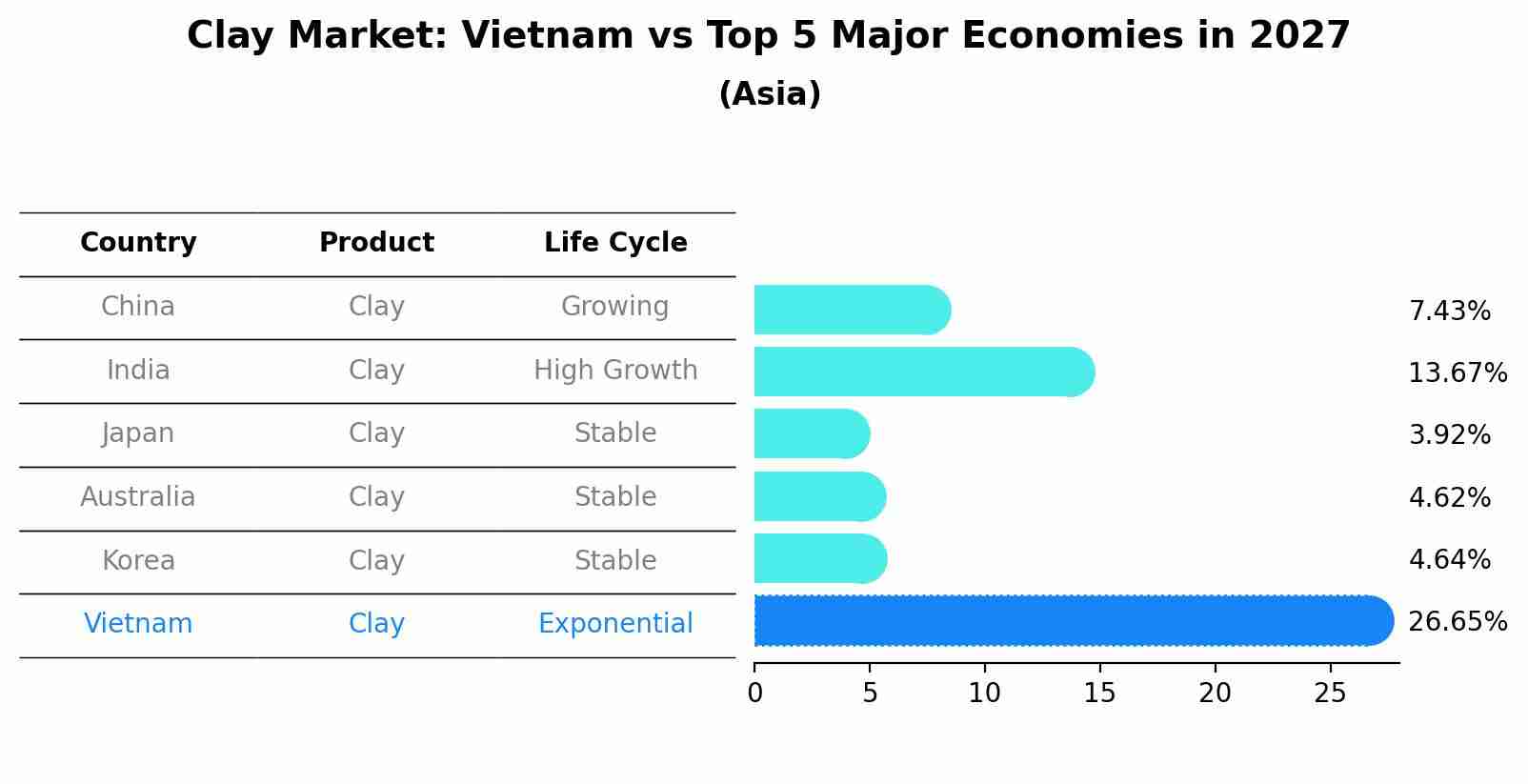Vietnam Clay Market (2025-2031) Outlook | Analysis, Revenue, Trends, Size, Industry, Forecast, Value, Growth, Companies & Share
| Product Code: ETC318990 | Publication Date: Aug 2022 | Updated Date: Aug 2025 | Product Type: Market Research Report | |
| Publisher: 6Wresearch | No. of Pages: 75 | No. of Figures: 35 | No. of Tables: 20 | |
Vietnam Clay Market Size Growth Rate
The Vietnam Clay Market is projected to witness mixed growth rate patterns during 2025 to 2029. Starting at 8.71% in 2025, the market peaks at 28.69% in 2028, and settles at 18.89% by 2029.

Clay Market: Vietnam vs Top 5 Major Economies in 2027 (Asia)
By 2027, Vietnam's Clay market is forecasted to achieve a exponential growth rate of 26.65%, with China leading the Asia region, followed by India, Japan, Australia and South Korea.

Vietnam Clay Market Synopsis
The Vietnam clay market involves the mining, processing, and distribution of various types of clay, which have diverse applications in industries like construction, ceramics, and cosmetics. The market`s performance is closely linked to construction and manufacturing activities in the country. Economic trends and infrastructure development significantly influence the demand for clay products, making it crucial for businesses in this market to monitor and respond to market dynamics effectively.
Drivers of the Market
The Vietnam clay market has witnessed steady growth due to multiple drivers. One of the prominent drivers is the construction and infrastructure development boom in the country. Clay is a crucial raw material in the production of bricks, tiles, and ceramics, which are essential building materials. With rapid urbanization and a surge in construction projects, the demand for clay products has increased significantly. Moreover, the expanding manufacturing and industrial sectors in Vietnam require clay for various applications, including ceramics, refractories, and pottery. Additionally, the tourism industry has fueled the demand for clay products like pottery and art pieces, leading to growth in the artisanal clay market. The availability of abundant clay deposits in Vietnam and the government`s support for the clay industry have further contributed to its growth.
Challenges of the Market
The Vietnam clay market faces challenges related to market saturation and competition. The clay industry may struggle with oversupply and pricing pressures if demand does not keep pace with production capacity.
COVID-19 Impact on the Market
The Vietnam clay market, including clay products and refractories, experienced disruptions in construction and manufacturing sectors due to the pandemic. Lockdowns and reduced economic activity slowed down construction projects and industrial operations, impacting the demand for clay-based products. Companies in the Vietnam clay market had to temporarily halt or slow down production and adjust their inventory management strategies to cope with decreased demand.
Key Players in the Market
In the Vietnam clay market and clay blocks market, notable companies include ClayTech Vietnam, TerraBlocks Ltd., and EarthCraft Ceramics. They supply different types of clay and clay blocks used in construction, pottery, and ceramics production.
Key Highlights of the Report:
- Vietnam Clay Market Outlook
- Market Size of Vietnam Clay Market, 2024
- Forecast of Vietnam Clay Market, 2031
- Historical Data and Forecast of Vietnam Clay Revenues & Volume for the Period 2021-2031
- Vietnam Clay Market Trend Evolution
- Vietnam Clay Market Drivers and Challenges
- Vietnam Clay Price Trends
- Vietnam Clay Porter's Five Forces
- Vietnam Clay Industry Life Cycle
- Historical Data and Forecast of Vietnam Clay Market Revenues & Volume By Application for the Period 2021-2031
- Historical Data and Forecast of Vietnam Clay Market Revenues & Volume By Tableware for the Period 2021-2031
- Historical Data and Forecast of Vietnam Clay Market Revenues & Volume By Sanitary ware for the Period 2021-2031
- Historical Data and Forecast of Vietnam Clay Market Revenues & Volume By Medical applications for the Period 2021-2031
- Historical Data and Forecast of Vietnam Clay Market Revenues & Volume By End Use for the Period 2021-2031
- Historical Data and Forecast of Vietnam Clay Market Revenues & Volume By Ceramic and for the Period 2021-2031
- Historical Data and Forecast of Vietnam Clay Market Revenues & Volume By Non-ceramic for the Period 2021-2031
- Vietnam Clay Import Export Trade Statistics
- Market Opportunity Assessment By Application
- Market Opportunity Assessment By End Use
- Vietnam Clay Top Companies Market Share
- Vietnam Clay Competitive Benchmarking By Technical and Operational Parameters
- Vietnam Clay Company Profiles
- Vietnam Clay Key Strategic Recommendations
Frequently Asked Questions About the Market Study (FAQs):
1 Executive Summary |
2 Introduction |
2.1 Key Highlights of the Report |
2.2 Report Description |
2.3 Market Scope & Segmentation |
2.4 Research Methodology |
2.5 Assumptions |
3 Vietnam Clay Market Overview |
3.1 Vietnam Country Macro Economic Indicators |
3.2 Vietnam Clay Market Revenues & Volume, 2021 & 2031F |
3.3 Vietnam Clay Market - Industry Life Cycle |
3.4 Vietnam Clay Market - Porter's Five Forces |
3.5 Vietnam Clay Market Revenues & Volume Share, By Application, 2021 & 2031F |
3.6 Vietnam Clay Market Revenues & Volume Share, By End Use, 2021 & 2031F |
4 Vietnam Clay Market Dynamics |
4.1 Impact Analysis |
4.2 Market Drivers |
4.2.1 Increasing demand for eco-friendly products in construction industry |
4.2.2 Growth in infrastructure development projects in Vietnam |
4.2.3 Rising adoption of clay products for interior and exterior decorations |
4.3 Market Restraints |
4.3.1 Fluctuating raw material prices |
4.3.2 Competition from alternative building materials like concrete and steel |
4.3.3 Lack of awareness about the benefits of using clay products |
5 Vietnam Clay Market Trends |
6 Vietnam Clay Market, By Types |
6.1 Vietnam Clay Market, By Application |
6.1.1 Overview and Analysis |
6.1.2 Vietnam Clay Market Revenues & Volume, By Application, 2021-2031F |
6.1.3 Vietnam Clay Market Revenues & Volume, By Tableware, 2021-2031F |
6.1.4 Vietnam Clay Market Revenues & Volume, By Sanitary ware, 2021-2031F |
6.1.5 Vietnam Clay Market Revenues & Volume, By Medical applications, 2021-2031F |
6.2 Vietnam Clay Market, By End Use |
6.2.1 Overview and Analysis |
6.2.2 Vietnam Clay Market Revenues & Volume, By Ceramic and, 2021-2031F |
6.2.3 Vietnam Clay Market Revenues & Volume, By Non-ceramic, 2021-2031F |
7 Vietnam Clay Market Import-Export Trade Statistics |
7.1 Vietnam Clay Market Export to Major Countries |
7.2 Vietnam Clay Market Imports from Major Countries |
8 Vietnam Clay Market Key Performance Indicators |
8.1 Percentage increase in usage of clay products in construction projects |
8.2 Number of new infrastructure projects utilizing clay materials |
8.3 Customer satisfaction ratings for clay products |
8.4 Adoption rate of clay products in interior design projects |
8.5 Environmental impact assessment of clay products compared to alternatives |
9 Vietnam Clay Market - Opportunity Assessment |
9.1 Vietnam Clay Market Opportunity Assessment, By Application, 2021 & 2031F |
9.2 Vietnam Clay Market Opportunity Assessment, By End Use, 2021 & 2031F |
10 Vietnam Clay Market - Competitive Landscape |
10.1 Vietnam Clay Market Revenue Share, By Companies, 2024 |
10.2 Vietnam Clay Market Competitive Benchmarking, By Operating and Technical Parameters |
11 Company Profiles |
12 Recommendations |
13 Disclaimer |
- Single User License$ 1,995
- Department License$ 2,400
- Site License$ 3,120
- Global License$ 3,795
Search
Related Reports
- ASEAN and Thailand Brain Health Supplements Market (2025-2031) | Strategy, Consumer Insights, Analysis, Investment Trends, Opportunities, Growth, Size, Share, Industry, Revenue, Segments, Value, Segmentation, Supply, Forecast, Restraints, Outlook, Competition, Drivers, Trends, Demand, Pricing Analysis, Competitive, Strategic Insights, Companies, Challenges
- ASEAN Bearings Market (2025-2031) | Strategy, Consumer Insights, Analysis, Investment Trends, Opportunities, Growth, Size, Share, Industry, Revenue, Segments, Value, Segmentation, Supply, Forecast, Restraints, Outlook, Competition, Drivers, Trends, Demand, Pricing Analysis, Competitive, Strategic Insights, Companies, Challenges
- Europe Flooring Market (2025-2031) | Outlook, Share, Industry, Trends, Forecast, Companies, Revenue, Size, Analysis, Growth & Value
- Saudi Arabia Manlift Market (2025-2031) | Outlook, Size, Growth, Trends, Companies, Industry, Revenue, Value, Share, Forecast & Analysis
- Uganda Excavator, Crane, and Wheel Loaders Market (2025-2031) | Strategy, Consumer Insights, Analysis, Investment Trends, Opportunities, Growth, Size, Share, Industry, Revenue, Segments, Value, Segmentation, Supply, Forecast, Restraints, Outlook, Competition, Drivers, Trends, Demand, Pricing Analysis, Competitive, Strategic Insights, Companies, Challenges
- Rwanda Excavator, Crane, and Wheel Loaders Market (2025-2031) | Strategy, Consumer Insights, Analysis, Investment Trends, Opportunities, Growth, Size, Share, Industry, Revenue, Segments, Value, Segmentation, Supply, Forecast, Restraints, Outlook, Competition, Drivers, Trends, Demand, Pricing Analysis, Competitive, Strategic Insights, Companies, Challenges
- Kenya Excavator, Crane, and Wheel Loaders Market (2025-2031) | Strategy, Consumer Insights, Analysis, Investment Trends, Opportunities, Growth, Size, Share, Industry, Revenue, Segments, Value, Segmentation, Supply, Forecast, Restraints, Outlook, Competition, Drivers, Trends, Demand, Pricing Analysis, Competitive, Strategic Insights, Companies, Challenges
- Angola Excavator, Crane, and Wheel Loaders Market (2025-2031) | Strategy, Consumer Insights, Analysis, Investment Trends, Opportunities, Growth, Size, Share, Industry, Revenue, Segments, Value, Segmentation, Supply, Forecast, Restraints, Outlook, Competition, Drivers, Trends, Demand, Pricing Analysis, Competitive, Strategic Insights, Companies, Challenges
- Israel Intelligent Transport System Market (2025-2031) | Strategy, Consumer Insights, Analysis, Investment Trends, Opportunities, Growth, Size, Share, Industry, Revenue, Segments, Value, Segmentation, Supply, Forecast, Restraints, Outlook, Competition, Drivers, Trends, Demand, Pricing Analysis, Competitive, Strategic Insights, Companies, Challenges
- Uganda Precast and Aggregate Market (2025-2031) | Strategy, Consumer Insights, Analysis, Investment Trends, Opportunities, Growth, Size, Share, Industry, Revenue, Segments, Value, Segmentation, Supply, Forecast, Restraints, Outlook, Competition, Drivers, Trends, Demand, Pricing Analysis, Competitive, Strategic Insights, Companies, Challenges
Industry Events and Analyst Meet
Our Clients
Whitepaper
- Middle East & Africa Commercial Security Market Click here to view more.
- Middle East & Africa Fire Safety Systems & Equipment Market Click here to view more.
- GCC Drone Market Click here to view more.
- Middle East Lighting Fixture Market Click here to view more.
- GCC Physical & Perimeter Security Market Click here to view more.
6WResearch In News
- Doha a strategic location for EV manufacturing hub: IPA Qatar
- Demand for luxury TVs surging in the GCC, says Samsung
- Empowering Growth: The Thriving Journey of Bangladesh’s Cable Industry
- Demand for luxury TVs surging in the GCC, says Samsung
- Video call with a traditional healer? Once unthinkable, it’s now common in South Africa
- Intelligent Buildings To Smooth GCC’s Path To Net Zero













